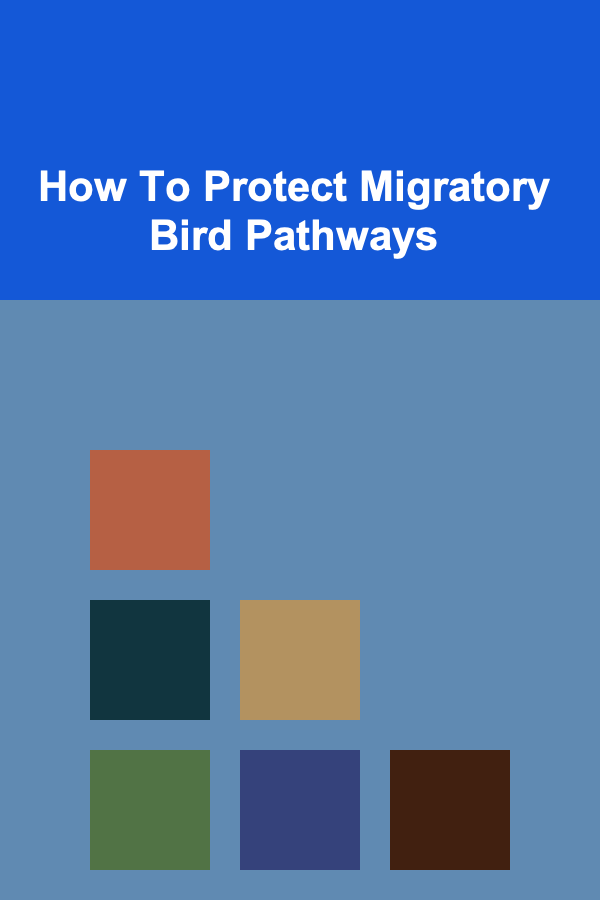
How To Protect Migratory Bird Pathways
ebook include PDF & Audio bundle (Micro Guide)
$12.99$6.99
Limited Time Offer! Order within the next:

Migratory birds are an essential part of our ecosystem, contributing to biodiversity, pest control, and the overall health of the environment. However, as human activities continue to encroach on natural habitats, the survival of migratory birds faces numerous challenges. Protecting migratory bird pathways is critical not only for the birds themselves but also for the broader ecological systems that rely on them. This article will delve into the importance of migratory birds, the threats they face, and the strategies that can be employed to protect their pathways.
The Importance of Migratory Birds
Migratory birds undertake long and often perilous journeys across continents, moving between breeding, feeding, and wintering grounds. These journeys, which can span thousands of miles, are not just impressive feats of endurance, but are also crucial for the survival of many species. The migration patterns of birds have developed over millennia and are finely tuned to environmental cues such as seasonal changes, food availability, and daylight patterns.
Ecosystem Roles
Migratory birds play several significant roles in maintaining ecological balance. These include:
- Pest Control: Many species of migratory birds consume large quantities of insects, rodents, and other pests. Their migration patterns help control populations of species that might otherwise become overabundant and damage ecosystems.
- Pollination: Some migratory birds, such as hummingbirds, are key pollinators. By traveling across vast distances, they help pollinate plants that rely on them for reproduction, thus maintaining healthy plant populations.
- Seed Dispersal: Birds are also important for seed dispersal, ensuring that plant species spread across the landscapes they traverse. This not only helps maintain the diversity of plant life but also promotes the growth of new plant populations in different areas.
- Nutrient Cycling: Birds contribute to the cycling of nutrients in ecosystems. Their droppings, for instance, provide essential nutrients to the soil, promoting plant growth. Additionally, as they feed on different species, they influence the distribution of organisms within the ecosystem.
Biodiversity and Climate Change
Migratory birds are a critical part of biodiversity. They help connect ecosystems across vast distances, creating links between different habitats that may be geographically isolated. The survival of migratory birds is closely tied to the health of the ecosystems they inhabit. Moreover, migratory birds are often indicators of broader environmental changes, particularly those caused by climate change. As temperatures rise and habitats shift, migratory birds are forced to adapt or face the risk of extinction. Protecting their pathways is essential to preserving biodiversity and mitigating the effects of climate change.
The Challenges Facing Migratory Birds
Despite their resilience and adaptability, migratory birds are facing an unprecedented number of threats. These threats are largely driven by human activity, and they significantly affect the ability of birds to navigate their traditional migratory routes.
Habitat Loss and Degradation
The most pressing threat to migratory birds is the loss of habitat. Urbanization, agriculture, deforestation, and industrial development all contribute to the destruction of critical habitats along migratory routes. Wetlands, forests, and coastal regions---vital stopover points for birds---are being drained, polluted, or developed, making it increasingly difficult for birds to find suitable resting, feeding, and breeding grounds.
Climate Change
Climate change has profound implications for migratory birds. Rising temperatures affect the timing of migration, food availability, and habitat suitability. Birds rely on specific environmental cues to time their migrations, and shifting weather patterns disrupt these cues, leading to mistimed migrations, reduced reproductive success, and increased mortality.
Climate change also exacerbates other threats to migratory birds. For example, extreme weather events such as hurricanes and droughts can damage habitats and destroy food sources. Furthermore, the changing climate is altering the geographical distribution of plant and animal species, meaning that the ecosystems birds rely on may no longer exist where they once did.
Collisions with Man-Made Structures
Birds face an increasing number of threats from human-made structures, including buildings, power lines, wind turbines, and communication towers. Collisions with these structures are a major cause of bird mortality. For example, thousands of birds die each year due to collisions with windows, especially during migration when birds are disoriented by artificial lights. Power lines and wind turbines are also significant hazards, particularly for larger species of birds.
Pollution
Pollution, in its many forms, poses a severe threat to migratory birds. Chemical pollutants, such as pesticides and heavy metals, contaminate the water and soil, reducing the availability of clean food and water sources. Oil spills, plastic waste, and other forms of pollution further degrade ecosystems and habitats, making them uninhabitable for birds.
Illegal Hunting and Trade
Illegal hunting and the illegal trade of birds and their eggs continue to be significant threats, particularly in certain regions of the world. Many species of migratory birds are targeted for food, feathers, or the pet trade. This not only reduces populations but also disrupts the migratory patterns of species that are heavily hunted.
Invasive Species
Invasive species, such as non-native plants, animals, and pathogens, can disrupt the delicate balance of ecosystems that migratory birds depend on. Invasive species may compete for resources, alter habitats, or introduce diseases that can decimate bird populations. For example, the introduction of non-native predators, such as rats or cats, can have devastating effects on ground-nesting birds.
Strategies for Protecting Migratory Bird Pathways
Given the numerous threats facing migratory birds, it is essential to take comprehensive action to protect their pathways. These strategies must involve a combination of habitat conservation, international cooperation, legal protections, and public awareness.
1. Habitat Protection and Restoration
One of the most effective ways to protect migratory bird pathways is through habitat conservation. This includes the protection of critical stopover sites, breeding grounds, and wintering habitats. Governments, conservation organizations, and local communities must work together to preserve these important areas from development and degradation.
In addition to protecting existing habitats, restoration efforts are equally important. Many habitats that were once suitable for migratory birds have been lost or degraded. Restoration projects that focus on replanting native vegetation, removing invasive species, and restoring wetland and forest ecosystems can provide birds with the resources they need to thrive.
2. Creating Migratory Bird Corridors
Migratory bird corridors are essential routes that provide safe passage for birds as they move from one region to another. Establishing protected corridors along key migratory routes helps ensure that birds have access to the resources they need at various points along their journey. These corridors can include a mix of protected areas, such as national parks, nature reserves, and wildlife refuges, as well as private lands that are managed for conservation purposes.
Governments and international bodies must collaborate to create these corridors and ensure that they remain undisturbed by human activity. Effective corridors can also help mitigate the effects of habitat fragmentation, allowing birds to move freely between different habitats.
3. Addressing Climate Change
Addressing climate change is a critical component of protecting migratory bird pathways. This requires both global and local efforts to reduce greenhouse gas emissions and limit the impact of climate change on ecosystems. Protecting forests, wetlands, and other natural habitats that serve as carbon sinks is essential in mitigating the effects of climate change.
Additionally, conservation efforts should focus on enhancing the resilience of bird populations and their habitats to climate change. This could involve managing ecosystems in a way that allows species to adapt to changing conditions, such as by creating wildlife corridors that connect fragmented habitats.
4. Mitigating Collisions with Structures
Efforts to reduce collisions with man-made structures, such as windows, power lines, and wind turbines, can significantly reduce bird mortality. Simple measures, such as installing bird-friendly glass on buildings, marking power lines with visible indicators, and using lighting systems that minimize disorientation during migration, can make a big difference in protecting birds.
Wind energy, which is often viewed as a renewable and environmentally friendly energy source, can also pose risks to migratory birds. However, wind farms can be designed with bird safety in mind, such as by siting them away from known migratory routes or using bird deterrents to minimize collisions.
5. Reducing Pollution
Reducing pollution is essential for creating safe environments for migratory birds. Efforts should focus on reducing chemical pollutants, controlling industrial waste, and limiting plastic pollution. Government regulations that restrict the use of harmful pesticides and promote sustainable agricultural practices can help protect both birds and their habitats.
Organizations and governments must also focus on addressing oil spills and other forms of pollution that disproportionately affect birds. This can be achieved through better waste management practices, oil spill response strategies, and stricter environmental regulations.
6. Strengthening Legal Protections
Legal protections for migratory birds are crucial to ensuring their survival. International agreements, such as the Migratory Bird Treaty Act in the United States and the Convention on Migratory Species, provide a framework for protecting birds across national borders. Strengthening these agreements and ensuring their enforcement can provide much-needed legal safeguards for migratory birds.
In addition, national laws that protect critical habitats and regulate hunting and trade are essential. Governments should also increase penalties for illegal hunting and the illegal trade of birds to deter these practices.
7. Public Awareness and Education
Raising public awareness about the importance of migratory birds and the threats they face is a key component of protecting bird pathways. Educating the public about the role of migratory birds in ecosystems and the need for conservation efforts can garner support for protection measures. Programs that encourage people to reduce their carbon footprints, protect local habitats, and support bird-friendly policies can make a significant difference.
In addition, citizen science initiatives that involve the public in tracking bird migrations, monitoring bird populations, and reporting sightings can help researchers gather valuable data that inform conservation efforts.
Conclusion
Migratory birds are an essential part of the natural world, and protecting their pathways is critical to ensuring their survival. The threats they face, including habitat loss, climate change, collisions with human-made structures, pollution, and illegal hunting, require comprehensive and coordinated action at local, national, and international levels. By focusing on habitat conservation, climate change mitigation, reducing mortality risks, strengthening legal protections, and raising public awareness, we can safeguard the future of migratory birds and the ecosystems they support. Through collective efforts, we can help ensure that these remarkable creatures continue to thrive and play their vital role in our world.
Reading More From Our Other Websites
- [Home Family Activity 101] How to Plan Seasonal Family Activities at Home
- [Toy Making Tip 101] From Concept to Celebration: How to Design a Custom Toy for Weddings
- [Toy Making Tip 101] Step-by-Step Guide to Making Classic Wooden Toys at Home
- [Personal Financial Planning 101] How to Secure Your Family's Financial Future with Life Insurance
- [Home Party Planning 101] How to Plan a Spa Party for Relaxation and Pampering
- [Personal Investment 101] Leveraging Deep Learning to Build a Profitable AI Business
- [Soap Making Tip 101] DIY vs. Commercial: Choosing the Right Soap-Molding Equipment for Your Business
- [Home Space Saving 101] How to Organize Your Pantry and Save Kitchen Space
- [Home Space Saving 101] How to Make a Small Room Look Bigger with Design and Decoration Tips
- [Screen Printing Tip 101] How to Achieve Vibrant Colors: Mastering Ink Selection & Mixing

How to Build a Deep Learning SaaS for Recurring Revenue
Read More
How to Choose Multi-Functional Furniture for Tiny Homes
Read More
How to Create a Focal Point in Each Room of Your Home
Read More
How to Create a Functional Laundry Room During Your Renovation
Read More
How to House Hack Your Way to Financial Freedom
Read More
10 Tips for Clicker Training Your Cat: A Comprehensive Checklist
Read MoreOther Products

How to Build a Deep Learning SaaS for Recurring Revenue
Read More
How to Choose Multi-Functional Furniture for Tiny Homes
Read More
How to Create a Focal Point in Each Room of Your Home
Read More
How to Create a Functional Laundry Room During Your Renovation
Read More
How to House Hack Your Way to Financial Freedom
Read More